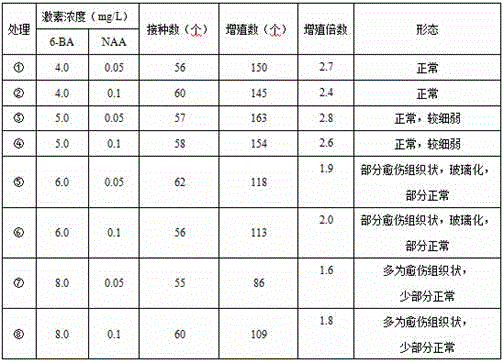Rapid propagation method of Gloriosa superba Linn
A fast and lily technology, applied in horticultural methods, botanical equipment and methods, horticulture, etc., can solve the problems of lily lily seed reproduction, low tuber reproduction coefficient, slow growth, etc., to achieve easy maintenance and management, and improve reproductive efficiency , the effect of fast growth
- Summary
- Abstract
- Description
- Claims
- Application Information
AI Technical Summary
Problems solved by technology
Method used
Image
Examples
Example Embodiment
[0023] Example 1
[0024] A. Selection and sterilization of explants: select the stem tips and axillary buds that grow robustly and have not formed flower buds as explants, peel off the outer leaves, and cut them into small sections of 1.5~2.0cm. Use conventional ones with appropriate detergent After washing with water, sterilize in a mercury-liter solution with a mass concentration of 0.1% for 7 minutes, and then in a sodium hypochlorite solution with a mass concentration of 0.3% for 5 minutes, then rinse with sterile water 4 times for 2 minutes each, and then use sterile filter paper Blot dry and set aside;
[0025] B. Adventitious bud induction culture: Under aseptic conditions, inoculate the small section after sterilization in step A into the following induction medium: MS+6-benzylaminopurine (6-BA) 6.0mg / L+naphthaleneacetic acid ( NAA) 0.01mg / L+agar 6.5 g / L+sucrose 30g / L, pH=5.8, under the conditions of culture temperature of 27℃, light intensity of 2000~3000lx, light
Example Embodiment
[0029] Example 2
[0030] A. Selection and sterilization of explants: select the stem tips and axillary buds that grow robustly and have not formed flower buds as explants, peel off the outer leaves, and cut them into small sections of 1.5~2.0cm. Use conventional ones with appropriate detergent After washing with water, sterilize in a 0.1% mass concentration of mercury solution for 8 minutes, and then sterilize in a 0.3% mass concentration of sodium hypochlorite solution for 4 minutes, then rinse with sterile water 4 times for 2 minutes each, and then use sterile filter paper Blot dry and set aside;
[0031] B. Adventitious bud induction culture: Under aseptic conditions, inoculate the small section after sterilization in step A in the following induction medium: MS+6-benzylaminopurine (6-BA) 7.0mg / L+naphthaleneacetic acid ( NAA) 0.03mg / L+agar 7.0 g / L+sucrose 30g / L, pH=5.8, culture temperature is 27℃, light intensity is 2000~3000lx, light time is 11h / d, induce culture for
Example Embodiment
[0035] Example 3
[0036] A. Selection and sterilization of explants: select the stem tips and axillary buds that grow robustly and have not formed flower buds as explants, peel off the outer leaves, and cut them into small sections of 1.5~2.0cm. Use conventional ones with appropriate detergent After washing with water, sterilize in a mercury-liter solution with a mass concentration of 0.1% for 10 minutes, and then in a sodium hypochlorite solution with a mass concentration of 0.3% for 3 minutes, then rinse with sterile water 3 times for 2 minutes each time, and then use sterile filter paper Blot dry and set aside;
[0037] B. Adventitious bud induction culture: Under aseptic conditions, inoculate the small section after sterilization in step A into the following induction medium: MS+6-benzylaminopurine (6-BA) 8.0mg / L+naphthaleneacetic acid ( NAA) 0.05mg / L+agar 6.8 g / L+sucrose 30g / L, pH=5.8, culture temperature is 27℃, light intensity is 2000~3000lx, light time is 12h / d, i
PUM
 Login to view more
Login to view more Abstract
Description
Claims
Application Information
 Login to view more
Login to view more - R&D Engineer
- R&D Manager
- IP Professional
- Industry Leading Data Capabilities
- Powerful AI technology
- Patent DNA Extraction
Browse by: Latest US Patents, China's latest patents, Technical Efficacy Thesaurus, Application Domain, Technology Topic.
© 2024 PatSnap. All rights reserved.Legal|Privacy policy|Modern Slavery Act Transparency Statement|Sitemap



